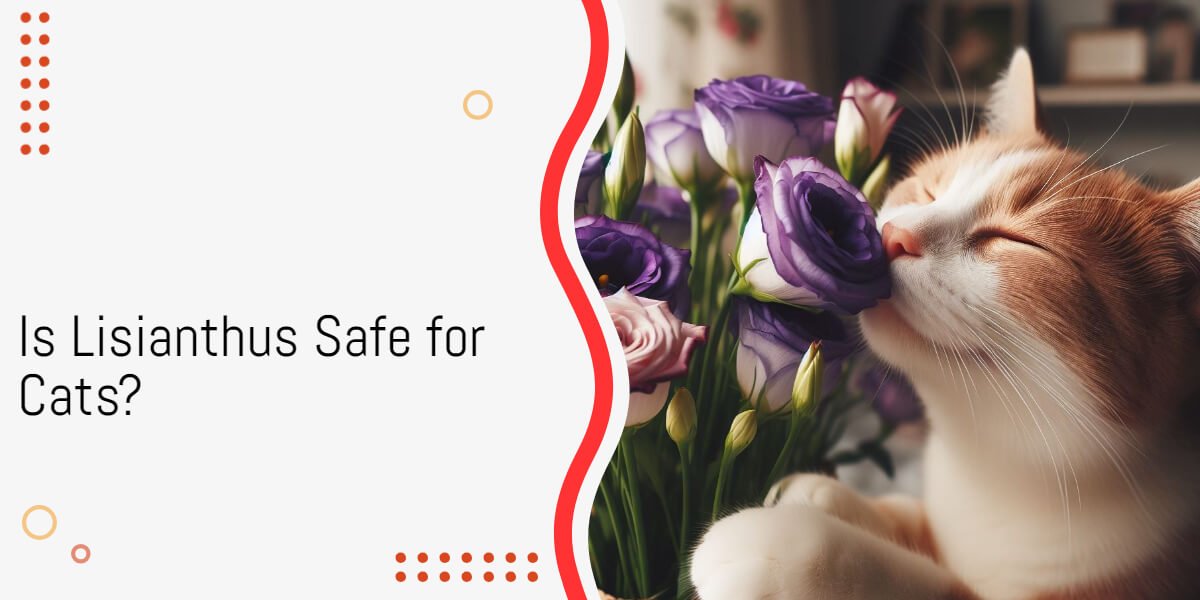Lisianthus blooms are completely non-toxic for cats and pose no health risks. All parts of the lisianthus plant, including the stems, leaves, and flowers, are safe if ingested by curious cats.
Table of Contents
What Are Lisianthus?
Lisianthus are beautiful bell-shaped flowers that come in white, purple, pink, and multi-colored varieties. Their name comes from Greek words meaning “smooth” and “flower.” They have delicate ruffled petals on a slender stem.
Lisianthus grows from a basal rosette of elongated dark green leaves. The leaves are around 5 inches long. The flowers bloom on straight stems that can grow 12-36 inches tall.
Are Lisianthus Poisonous to Cats?
The good news for cat owners is that lisianthus is not poisonous to cats according to the ASPCA. This means all parts of the plant, including the stems, leaves, and flowers, will not cause any issues if nibbled or ingested by your curious cat.
Even large ingestions of lisianthus are not likely to be problematic. At most, a cat may experience minor stomach upset or irritation if they eat a lot of the plant or flower.
So while lisianthus themselves are completely nontoxic, some general precautions should still be taken to limit a cat’s exposure.
How Much Lisianthus Is Dangerous to Cats?
Cats are unlikely to consume enough lisianthus to make themselves sick. A few nibbles or licks when investigating the plant will not cause any adverse health effects.
Significant poisoning would only occur if a cat ate multiple entire lisianthus plants and flowers. This large amount could potentially cause vomiting or diarrhea, but serious toxicity is very unlikely.
Symptoms of Lisianthus Poisoning in Cats
Possible symptoms if a cat ingested a substantial quantity of lisianthus include:
- Vomiting/diarrhea
- Decreased appetite
- Lethargy
- Stomach pain
These symptoms are not specific to lisianthus and can occur with overeating any plant material. They are not an indication of poisoning or toxicity in small ingestions. Only large, excessive ingestion might cause stomach upset.
What Are Some Other Flowers That Are Safe to Leave Around Cats?
In addition to being able to safely keep lisianthus around cats, many other flowers are also nontoxic for feline friends. Some additional cat-safe flowers are:
- Roses
- Sunflowers
- Daisies
- Lavender
- Pansies
- Snapdragons
It’s still smart to keep these flowers out of reach of cats to prevent stomach upsets from eating the greenery. But they will not cause poisoning if ingested.
Toxic Flowers for Cats
Some flowers that are poisonous to cats and should be avoided include:
All parts of these plants, including the flowers, leaves, and stems, can cause toxicity in cats. Make sure to keep arrangements containing any of these dangerous flowers well out of your cat’s reach.
Keeping Cats Out of Flower Arrangements
To be safe and keep your cat from munching on any flowers, here are some tips:
- Place flowers on high shelves or surfaces your cat can’t access
- Use flower vases that are tall and hard to tip over
- Sprinkle cayenne pepper or citrus peels around arrangements
- Use cat deterrent sprays on plants
Keeping flowers out of reach and using deterrents will help protect both your flowers and your cat. Monitor any new interest in plants and move them if needed.
Related Posts:
– Are Kimberly Queen Ferns Safe for my Cat?
– Discover Whether Bromeliads Are Toxic to Cats
– Are Bougainvillea Poisonous to Cats?
How Likely Are Cats to Ingest Poisonous Plants?
Much to our surprise because cats like to get involved with anything and everything, cats aren’t likely to eat a toxic plant or flower. The reason behind this is that cats know by instinct what to eat and what might hurt them.
This inner feeling has been ingrained in them for centuries and it dates back to the time when they had to search for food in the wild.
Still, it’s not usual for a young and inexperienced kitten to munch on something that she’s better off away from. Out of all plant poisoning cases, younger cats, who are naturally more curious, make up the majority of these instances.
What Are Some Plant Poisoning Symptoms to Watch For?
Even if you take all the proper precautions and keep toxic plants out of a cat’s reach, you must know how to identify the signs of plant poisoning to limit the damage. If a cat ingests the poisonous part of a plant, she might face:
- Increased salivation
- General discomfort, confusion, or incoordination
- Lethargy
- Vomiting or diarrhea
- Irritation of the skin, gums, eyes, or nose
- Fits, seizures, or twitching
- Breathing or swallowing difficulties
Upon noticing one or more of these troubling signs, a cat owner must reach out to a vet at once to understand how to act. In most cases, it would be an emergency that’ll require an immediate visit to the veterinarian.
The Bottom Line on Lisianthus and Cats
Lisianthus blooms and foliage are completely non-toxic to cats. All parts of the plant can be safely nibbled or ingested. At most, a cat may get an upset stomach from eating a very large amount.
While lisianthus is safe, some common flowers like lilies are very poisonous to cats. Always check before bringing new flowers into your home. Monitor your curious cat around any plants and move them out of reach when needed.
With proper precautions, you can safely enjoy lisianthus floral arrangements in your home without endangering your precious cats! Just take care to limit access and introduction of any known toxic flowers to keep your kitty safe.

I’ve been living with cats since 2008 and I can confidently say I have more feline friends than humans lol. I currently live with 5 cats in different life stages; two of them are less than one year old, one is 2-ish years old and the oldest two are 9-ish years old. I’ve developed a strong bond with cats over the years and I’m eager to share my experience through this blog. You can learn more about my cats here.

